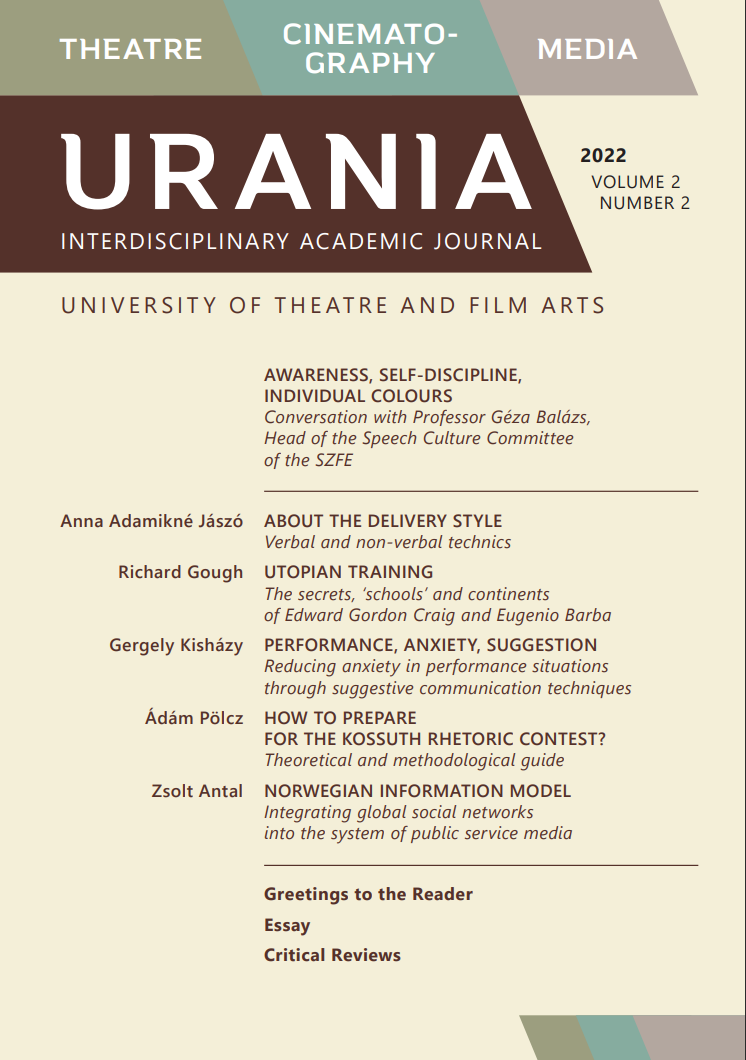Norwegian Information Model
Integrating global social networks into the system of public service media
Abstract
The Norwegian public service media model has served as a model in Europe for decades. However, the information revolution and the changes in social communication brought about by social networks have challenged the Norwegian government and the media authority, forcing them to create a new legal environment to adapt to the changed circumstances. This has been preceded and grounded by a professional and social debate, as a result of which Norway has successfully integrated global, profit-oriented social networks into the public service media system.
References
Antal Zsolt. 2011. Közszolgálati média Európában – az állami részvétel koncepciói a tájékoztatásban. (Public service media in Europe – The concepts of public participation in information.) Szeged: Gerhardus Kiadó.
Antal Zsolt. 2017. „Közszolgálati kommunikáció, közbizalom és médiaszabályozás.” (Public service communication, public trust and media regulation.) In Medias Res 2017/2 319–338. https://szakcikkadatbazis.hu/doc/4459648
Bayer Judit. 2008. A közszolgálati televíziózás újragondolása a digitális korszakban. (Rethinking public service television in the digital age.) Médiakutató 9/2 7–17. https://www.mediakutato.hu/cikk/2008_02_nyar/01_kozszolgalati_televiziozas_digitalis
Bajomi-Lázár Péter. 2009. Hírközlés tegnap és ma. (Broadcasting yesterday and today.) Médiakutató 10/3: 141–147.
Castells, Manuel. 2005. A hálózati társadalom kialakulása – Az információ kora, I. kötet. (The Rise of the Network Society – The Information Age, Volume I) Budapest: Gondolat Kiadó.
Habermas, Jürgen. 1971. A társadalmi nyilvánosság szerkezetváltozása. (Structural change in the social public sphere.) Budapest: Gondolat Kiadó.
Jakubowicz, Karol. 2007. Public Service Broadcasting: A Pawn on an Ideological Chessboard. In Media Between Culture and Commerce, editor: Els de Bens, Bristol: Intellect Books.
Moe, Hallvard. 2013. „Public Service Broadcasting and Social Networking Sites: The Norwegian Broadcasting Corporation on Facebook.” Media International Australia 146: 114–122. Viewed on 10 April 2022. https://journals.sagepub.com, https://doi.org/10.1177/1329878X1314600115
Nyakas Levente. 2015. A médiapluralizmus nyomában. A médiapluralizmus elvének elméleti alapjai és értelmezése az Európai Unió egyes politikáiban (különös tekintettel audiovizuális és -médiapolitikára), jogalkotásában és intézményi gyakorlatában. (In the wake of media pluralism. Theoretical foundations and interpretation of the principle of media pluralism in the European Union’s policies (with special regard to audiovisual and media policy), legislation and institutional practice.) Version prepared for discussion at the workplace. Doctoral thesis. Győr: Széchenyi István University.
Rumphorst, Werner. 2007. Model Public Service Broadcasting Law. Viewed on 10 April 2022. https://www.article19.org/wp-content/uploads/2018/02/model-psb-law.pdf
Sundet, V. S. 2008. Innovajson og nyskaping i NRK. En analyse av plattform- og sjangerbruk i Rubenmann-prosjektet. Nors Medietidsskrift, 154/4, 282–307.
SSB/MedieNorge. 2011. Tilgang til avisabonnement og antall abonnement.
Tóth Loretta. 2022. Az udvariatlanság pragmatikája. Diplomácia 280 karakterben: a nemzetközi kapcsolatok alakulása a twiplomácia aranykorában. (The pragmatics of impoliteness. Diplomacy in 280 characters: the evolution of international relations in the golden age of twiplomacy.) Doctoral thesis. Budapest: Corvinus University.




